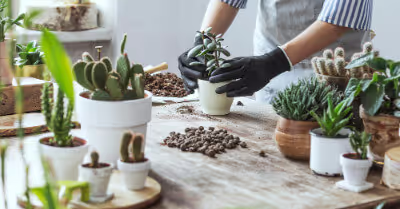Table of Contents
What is Softscape?
Softscape includes using plants and botanic elements to design your landscapes. You can either add the all-year-round plantation or seasonal flora; it’s all based on your space and preference.
Softscape refers to using soil, trees, shrubs, and grass to beautify your area and enhance the fresh airiness of your landscape.
While deciding the ideal softscape elements for your space, you must consider vital factors like sunlight, temperature, and water conditions. That ensures your satisfaction with your landscape throughout the year.
How Does Softscape Differ From Hardscape?
Hardscape elements consist of adding non-living aspects while planning your landscape. They can range from driveways and paving to stairs and retaining walls. On the other hand, softscape comprises living additions, specifically plantations.
Typically, you need to install or construct hardscape elements before adding the softscape features. For instance, you must first incorporate fences or retaining walls before applying soil and adding grass to the area.
In addition, hardscape elements are moveable and adjustable. Things like gavels and stones can be replaced or moved from one place to another. However, once you plant and grow a tree, you certainly can’t change its position unless you cut it down.
A combination of hardscape and softscape elements is perfect for beautifying your landscape. And so, the botanic and non-living installations go hand-in-hand for designing a well-maintained, neat, and appealing space.
Brilliant Ways To Include Softscape Elements In Your Gardens
As you add greenery to your landscaping, there are some noteworthy rules to remember and implement. We offer seven tips to master your softscape landscaping smoothly.
Find The Balance
It’s challenging to use softscape or hardscape elements alone and boost the visualization of your landscape. So, the fundamental step is to strike the correct blend between both components.
You need things like stones or retaining walls to create a safety boundary and add class to your area. And similarly, you need some greenery around it to add serenity to the overall landscape.
It doesn’t matter how bright and colorful you paint the retaining wall. It will still look dull and uninspiring if you don’t add natural features like lush grass or some shrubs near it.
Add Softness To The Corners
Hard corners might seem sharp and rough. But you can create homely vibes around your patio by planting tall grass. That’s even more strategic when you plan to design your family home’s landscaping.
Having vibrant flowers or grasses close to the walkways softens the hard edges and enhances the snugness of the area. Having a mini garden close to your patios can also help make the space mediative and serene for you.
You’d also be surprised to realize that greenery can make even the most compact places seem vast and spacious. That’s why softscape elements are best for you if you want to design your small patio or narrow walkway to look roomy and uncluttered.
Select Suitable Plantations
Softscape elements differ for every area, size, and lifestyle. As you select plantations to optimize your landscape, you need to consider several things.
You can’t simply select any tree or shrubs for your layout. So, it’s always best to consider your preferences and requirements. For instance, you can go for annual plants. They bloom and alleviate your exterior during summers and winter, both.
In addition, if you prefer low-maintenance flora, you can also opt for native plants. You don’t need high research to understand their requirements. And they can grow easily due to their high compatibility with the native weather conditions.
Furthermore, if you value a fragrant garden that offers cozy and peaceful vibes, you can opt for flowering perennials. Plants like Lavender, Asters, Summer Lilacs, or Hydrangeas cast a welcoming and nature-loving glow to your landscape.
Vines are remarkable bursts of greens to excel at creating a landscape with hardscape and softscape elements. Climbing vibes for your gazebos or on the retaining walls offer soothing appeal.
In addition, wooden and metal fences or rails might look very straightforward. However, hanging vines can cover the empty gaps between the fences and hide the underwhelming metal.
Have Extra Area Around The Softscape Elements
As you prepare the land for your softscape landscaping, it’s crucial to save and leave space around them.
You might forget that softscape elements require more area for their growth. As the roots develop, they spread across the ground, and the leaves and flowers bloom to occupy more space, horizontally and vertically.
As you select flowers, trees, and vines, you must understand that they will evolve with time. So, you must plant them at a distance from each other and not just clutter them too close.
Include Flowering Plants For The Color
Vines and meadow grasses are impressive elements to make your landscape look sophisticated and tidy. However, even the lush greenery might seem underwhelming if you don’t include flowering plants.
Colorful flowering plants can do wonders for areas like backyards and porches! Small plants in contrasting shades make your landscape even more gorgeous and offer pleasant scents near the area.
You can walk around and take early morning strolls as you inhale the revitalizing and blissful fragrances. As the ideal bonus, you also enjoy viewing the bright-colored flora!
Decorate The Driveway And Terrace Naturally
You can make your driveways and terraces the focal points of your landscapes. Adding softscape elements is one of the most tactical ways to accomplish that.
Softscape elements are convenient options to utilize your space more efficiently. For instance, you can transform your terraces into vegetable gardens. Or, you can design the driveway to look eye-catchy flowering plants and trimmed grass.
Driveways and walkways lined with shiny stones and perennials look orderly and organized. Such well-managed spaces enhance the overall décor of your landscaping.
Plan Out Routine Maintenance
Venturing into the art of softscape landscaping is intriguing, and once you delve deep into it, it’s hard not to overdo it.
You have numerous opportunities and options to decide from: grapevines and tall grasses or lively perennials and shrubs. While they might look exceptional and phenomenal for your exterior, you must also determine how easy they are to maintain.
Growing flora isn’t the only part, after all. You also need to manage their growth, cut the dead pieces, and schedule pesticide and fertilizing routines.
So, if you have a busy life and can’t spend much time gardening, you must go for the plantation with quicker maintenance. In addition, you need to check the climatic and soil requirements of the flora too.
If you want a plantation with extended life, you can include perennial plants that grow every year. You can also opt for succulents that require less tending and flexible watering plans.
Benefits Of Softscape Elements
Softscape elements are essential assists to incorporate in your landscape design. Planting greenery in your space makes the area look well-maintained and decluttered.
The plantation also helps to create focal points in your landscape to make the exterior more eye-grabbing and versatile. Most of the time, hardscapes or softscapes alone don’t do your area enough justice.
Therefore, you can become a pro at landscape designing and create the ultimate space, which is the epitome of practical picturesqueness.
As you think about including softscape features, you must know its basics and vital ways to add them to your space. And that’s how reading a guide to softscape elements can enable you to address every fundamental concept to decorate your landscape better.
Recent Articles

















